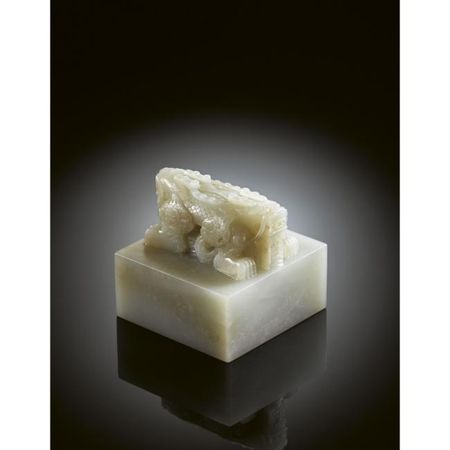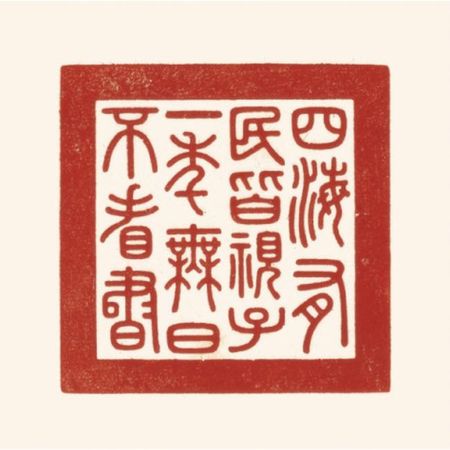An important imperial white jade 'dragon' seal. Qing dynasty, Qianlong period made on the 20th day of the second month of the 53
An important imperial white jade 'dragon' seal. Qing dynasty, Qianlong period made on the 20th day of the second month of the 53 year (corresponding to 1788). photo Sotheby's
of square form, surmounted by a superbly carved pair of addorsed dragons, each powerfully carved with eyes bulging and nostrils flaring above curling whiskers, the scales and flowing mane finely incised, the two scaly bodies intertwined and crouching on the haunches, pierced through the centre with an aperture, the square seal deeply and crisply carved with the characters si hai you min jie si zi, yi nian wu re bu kan shu ('All the people within the Four Seas I look upon as my children, throughout the year not a day goes by I do not engage in study), the stone of pure grey white tone with small white inclusions and natural veining - length 7.5 cm., 3 in. height 6.9 cm., 2 3/4 in. Est. 10,000,000—15,000,000 HKD. Lot Sold 20,260,000 HKD
PROVENANCE: Sotheby's Hong Kong, 9th October 2007, lot 1302.
NOTE:
Emperor Qianlong's 'Si hai you min jie si zi, yi nian wu ri bu kan shu' Seal. by Guo Fuxiang, Department of Palace History, The Palace Museum, Beijing
The fourteen-character poem on the seal face can be translated as follows:
All the people within the Four Seas I look upon as my children,
Throughout the year not a day goes by I do not engage in study
This seal is recorded in the Collection of Qianlong Emperor's Treasure Seals. Looking at the quality, size and the arrangement of the characters written in the zhuanshu style, it is clear that this seal is the actual one mentioned in the imperial records and is the genuine Qianlong seal. The origins of the seal, as well as the making of it is recorded in detail as the seal was of significant importance among the treasure seals of the emperor and his family.
The Qianlong Emperor was an extremely cultured and learned person. He was fond of writing poetry and was interested in literature. He wrote over forty thousand poems and essays, many of which are of high standard. He often had his poems carved on his treasure seals. One of the main characteristics of Qianlong's treasure seals is that they are carved with the emperor's writings. The style and the content of his writings often reflected his thoughts. The fourteen-characters carved on this seal are from one of his poems written in the 47th year of his reign (equivalent to 1782 A.D.).
In 1782, the emperor spent the summer at his Summer Palace in Re He as usual. On the fourteenth day of the sixth month, while he was taking a stroll around the buildings, he saw a pair of hanging scrolls, one of which was inscribed with a poem by the famous calligrapher Zhang Zhao. The poem can be translated as follows:
"All the surrounding mountains are depicted in this painting. Not a single day in a year passes by that I do not look at the flowers.''
The Qianlong Emperor stopped and admired this pair of hanging scrolls. Zhang Zhao, zi De Tian, hao Jing Nan, was from Songjiang in Shanghai. He was a court artist and served under three Qing emperors, Kangxi, Yongzheng and Qianlong. Qianlong especially favoured him for his calligraphy. Zhang's calligraphy was rich, fluent and powerful. It can be said that his calligraphy excelled that of many of the famous calligraphers such as Zhao Mengfu and Dong Qichang. But this time it was the content of Zhang's poem that captured the emperor's interest. After giving it a thought, Qianlong changed five characters of the original poem and wrote his own version. He completely changed the meaning of Zhang's poem, and wrote a poem that reflected his own thoughts. Qianlong recalled this event during his visit to the Yuanmingyuan in the following year, proudly declaring how he had changed the meaning of the original poem.
However, Qianlong remained curious about the circumstances of Zhang's poem. As it happens, Zhang had copied two lines from a pair of hanging scrolls he had seen at the residence of Lu Shen. Lu Shen was also a native of Songjiang. He became a jingshi, in the 18th year of Minghong of the Ming Dynasty. He was famous for his essays and calligraphy. His works are compiled in The Yan Shan Collection where the poem written on the hanging scroll can be found. The complete poem can be translated as follows:
"All the surrounding mountains are depicted in one seat.
Not a single day in a year passes by that I do not look at the flowers.
How can I walk on the path to heaven,
When the boat is floating on the shallow sand of spring water.''
Both Lu Shen and Zhang Zhao were natives of Songjiang. Zhang must have been familiar with Lu's work and it is not surprising that he quoted Lu. However, it is important to note that Zhang did not copy Lu's lines completely but changed one character. He had replaced the character zuo (seat) with hua (painting).
According to the archival records dated to the 20th day of the second month of the 53rd year of Qianlong's reign, an imperial decree was received ordering the making of six imperial jade seals for presentation. Six pieces of jade of different sizes were selected, of which three were used to make seals with dragon handles. The Emperor approved the samples and the seals were made accordingly. A jade piece weighing five jin was used for making a seal with the dragon design. The size of the seal was 2.4 inches in width and 2.2 inches in height. It was carved with the characters 'Si hai you min jie si zi, yi nian wu ri bu kan shu'. From this record, we know that the present seal was made in the 53rd year of Qianlong's reign (equivalent to 1788 A.D.), six years after the Emperor had seen the hanging scrolls with Zhang's poem.
The present seal was made by craftsmen who worked under the orders of the Neiwufu (Imperial Household Department). It is known that from the mid to late Qianlong period, a great number of jade artifacts were made for the palace by craftsmen working in the Suzhou Region. However, this seal is an example of the craftsmanship achieved in the Changlu Region. It is interesting to note the stylistic differences between the different regions making pieces on Imperial order.
From the original text by Lu Shen, to Zhang Zhao's version and then to Qianlong's 'Si hai you min jie si zi, yi nian wu ri bu kan shu', this seal embodies the emperor's inner thoughts and his commitment to his people.
Sotheby's. FINE CHINESE CERAMICS & WORKS OF ART. 08 Apr 10. Hong Kong www.sothebys.com

/https%3A%2F%2Fprofilepics.canalblog.com%2Fprofilepics%2F1%2F0%2F100183.jpg)
/https%3A%2F%2Fstorage.canalblog.com%2F03%2F02%2F119589%2F96711876_o.jpg)
/https%3A%2F%2Fstorage.canalblog.com%2F11%2F31%2F119589%2F94773502_o.jpg)
/https%3A%2F%2Fstorage.canalblog.com%2F20%2F83%2F119589%2F94772815_o.jpg)
/https%3A%2F%2Fstorage.canalblog.com%2F26%2F72%2F119589%2F75604929_o.jpg)
/https%3A%2F%2Fstorage.canalblog.com%2F59%2F60%2F119589%2F26458628_o.jpg)







/image%2F1371349%2F20240415%2Fob_308536_436292768-1650079115762101-83406494688.jpg)
/image%2F1371349%2F20240415%2Fob_33cd12_436341308-1650083962428283-83512798383.jpg)
/image%2F1371349%2F20240415%2Fob_96e312_436340642-1650637962372883-45552336993.jpg)
/image%2F1371349%2F20240415%2Fob_ccc69c_dp280848.jpg)